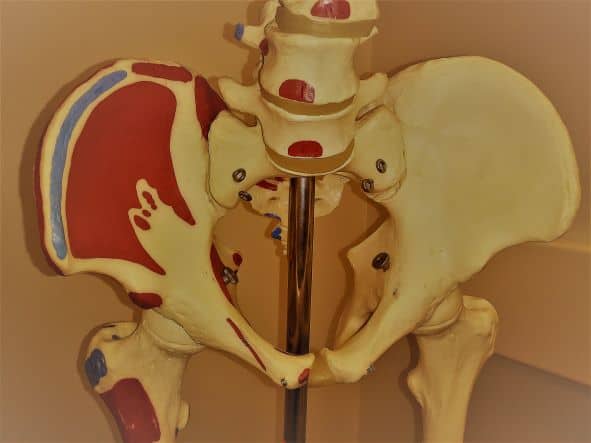
Pelvic health physical therapy has an interesting history. In my experience, it’s a service that many therapists are not interested in providing, and it encompasses issues that are not often talked about.
But it seems to keep coming up in my world. At least two people I talked to in preparation for my Professional Resolutions article are interested in taking courses in pelvic health. Clinics around me are expanding to provide pelvic health as part of their services, and then a good friend, newly postpartum, suggested that it would be an interesting topic for an article. So I listened to all the signs and here we are!
Conversation with a Pelvic Health Specialist
Anna Grondski, PT, DPT, a physical therapist that specializes in pelvic health issues at Personal Best Physical Therapy was kind enough to answer all of my questions surrounding the topic.

How did you get interested in this? What made you pursue it?
[My former boss] approached me one day and was like, “Hey, we’d like someone to offer this service, treat this population” and I was interested in it. Pelvic health is kind of taboo. A lot of people don’t feel comfortable talking about those issues, so it was definitely an area that was needed.
Tell me about the training.
I was trained through the APTA (American Physical Therapy Association). There’s also Herman & Wallace; they’re very popular as well. With the APTA I took 5 courses: pelvic health 1, 2, and 3, and then postpartum and advanced postpartum. The APTA training is very evidence-based, which is great. They definitely put a huge emphasis on that, so every step of the way they’re talking about what the evidence says.
Were you treating patients with pelvic health issues while you were taking the courses?
Once you take level 1 you can start. The information builds on itself.
And it probably helps to have the experience as you go through it.
Absolutely.
Did the internal component of pelvic health physical therapy ever scare you?
When you go see your OB (obstetrician) they are not always kind or gentle; it’s like, no big deal, no warning, here comes the speculum. After having some of that experience, I always try to make sure that someone doesn’t have that experience with me. So, if anything, I was just nervous to make sure that the patient felt comfortable. Other than that, you realize that it’s not always easy to find someone that treats these issues, and they are muscles like all the others that we treat.
What types of conditions do you treat?
Mainly urinary incontinence, but also pelvic pain, and postpartum, getting back into regular life and exercise, scar mobilizations. I’ve treated males for pelvic pain, and I am also cleared to treat males after prostate surgery.
I’ve also treated children. With them, it’s usually related to constipation. Once children get to the point that they can control their bowels, it’s the one thing that they have to control. They want to hold onto that. Part of it is that power struggle and then part of it is, “No, I’m playing outside, I don’t want to go inside to use the bathroom.” Then they end up with a distended rectum, a megarectum, with a large amount of compacted stool. Then there’s loose stool that ends up traveling above and below it so they end up with loose stools and then the parents think, “Oh, well they’re not constipated, their stools are loose,” but really they’re only getting a little bit leaking out.
With them, it’s a matter of parent education, getting them to eat more fiber and have a more well-rounded diet, increase water intake, exercise, and bowel massage.
Children of all ages?
Five and up. I believe 5 is the cut-off. Before then there are too many other factors.
Tell me about patient responses to this type of treatment. Are patients surprised, are they uncomfortable, are they open? What do you get?
A little bit of everything. The first visit can be a little challenging because you’re trying to gauge where they’re coming from, what their past experience was, or what their expectations are. I’ve had some patients who are gung-ho, “Yeah, I’m ready. Whatever you need to do. Let’s do the internal exam today.” But I usually just talk on the first day. I can give them enough information to start them on the right track, to start on their healing, just with different ideas, talking about the anatomy, what’s normal, what isn’t normal. I feel like as women, you don’t have anyone that tells you what’s normal and what isn’t.
I think that a lot of women assume that incontinence is normal as they age.
That too. But even before then, no one tells you that, for example, hovering over a public toilet isn’t good for your pelvic floor. No one tells you that ‘power peeing’ or forcing the urine out because [you are in a hurry] isn’t good. There are little things that we do that you realize can be detrimental to the long-term health of your pelvic floor.
One of the things that I often talk about on that first visit is how much our bowels contribute, and that’s something that people aren’t usually prepared to talk about. They don’t realize how closely related it is. With incontinence, constipation will often make it worse. If the pelvic floor is weak and now there’s literally more weight, more pressure pushing down on the pelvic floor because there’s extra stool that hasn’t been passed, then there’s going to be more urinary leakage.
The main thing is water. Most of us don’t realize how much water we should be taking in. You hear about 8 cups a day, but what does that mean really? And that varies from body to body. My recommendation is half of your body weight in ounces; that’s how much water we should be taking in. More if you are exercising, or if it’s really hot. Just with starting to talk about those things, people say, “Well, I definitely don’t drink enough water because I’m afraid I’m going to leak.” Then they end up getting constipated, and that contributes to their symptoms even more.

Is there a period where they will leak more and it has to even out?
There will be a period of time where you feel like you have to go to the bathroom constantly. If someone goes from drinking 10 ounces to 60, 80, 100 ounces- that’s a huge difference. Yeah, your body is going to get a little overloaded, and there’s going to be an adjustment period. But it does even out.
One of the other big issues is urinary frequency, feeling that they have to go to the bathroom very often. The bladder is pretty incredible in how it learns to take control of the brain. It will start to give us cues that we have to go when we don’t really have to.
As the bladder fills, it’ll give you the first signal to empty your bladder when you’re at about 40-50% capacity. So if, just because you’re home all the time and it’s convenient, or because you’re afraid of leaking, say your bladder fills to 40-50% and you empty it. And you do that all day long. Well, now your bladder is only getting used to filling that amount and it becomes more resistant to stretch. Now it will shrink a little bit. And now when it gives you the signal at 50%, well it’s, say that’s 10% less than what it was a year ago; you start getting the signal sooner.
Then the other part of it is our ‘brain bladder’ will start to associate different activities with going to the bathroom. That could be leaving the house, or putting your keys in the door, or running water. And then it starts to become that you’re out in the real world and you walk by a waterfall, you’re like, “Crap, I have to pee.” That’s the bladder brain connection doing that to you.
So is it better to hold it?
What we want to try to figure out is if they are getting those signals prematurely. It’s a good habit to get into to count the duration of your flow when you’re urinating. Most of the time our bladder will be the fullest first thing in the morning. So say, first thing in the morning your flow is 10 seconds long, and that’s your highest number throughout the whole day. We can guess that your bladder capacity is 10 seconds worth of volume. Then say you come home, you put your key in the door, and “Oh, my gosh, I have to pee.” You go to the bathroom and your flow is 4-5 seconds. That means you didn’t really have to pee. You use that to help you plan for the next time.
If you don’t really have to go, you can usually put it off. You can try 5 quick Kegels to give the pelvic floor and the bladder a different sensation. You can try to distract yourself and do something else. Because, again, the mind has kind of taken over.
I usually have people fill out a bladder diary for two common days and a weekend day to help them figure out what their schedule is, and different cues to look out for to help them plan for the future. They can start to keep a running tally in their mind of ‘How much water am I drinking? When’s the last time I had water? When’s the last time I went to the bathroom? Do I have to go again?’ based on experience.
So it’s like all other physical therapy in the way that it’s retraining your body out of a dysfunctional pattern.
Yeah, something that’s difficult to measure because you can’t see it, you have to measure it in other ways.
I kept a bladder diary for myself when I was 8, 9 months pregnant because now there’s extra weight on the bladder. There’s less capacity to stretch. And I’m at home for the last month, feeling like I need to go all the time. I was counting my flows, both to help me as a PT but also for myself to get a better understanding of what my bladder is really telling me. It was helpful, and I definitely tried those tactics of trying to put it off a little bit.
Kegel exercises are an automatic association with pelvic floor physical therapy. How much of a role do they play?
A Kegel is a term for the contraction of the pelvic floor muscles (PFM). If the patient’s primary issue is weakness then traditional Kegel exercises will be very important in their therapy early on. But eventually, you want to progress those exercises to be more functional and dynamic. You want to learn to coordinate breathing with PFM contraction, as well as movement of the limbs and trunk while fighting gravity. But if someone has PFM tightness as their primary issue, straight Kegels will just make it worse. They need to lengthen and stretch their PFM muscles.
Are your referral sources primary care doctors, or is it mostly OBs?
A little bit of both. And sometimes patients that come into the clinic see the flier, or they hear someone talk, and they say, “Oh, I didn’t realize you offered that service.” Or I’ll be talking to a patient about what they’re coming in for and they’ll say, “I have this other issue that I am seeing my OB for or a urogynecologist.” I’ll say, “Well, tell me about it, I actually treat these issues.” I’ve had a couple of patients that I started seeing for another issue that started that way.
What would you want other PTs to know about pelvic health physical therapy?
There’s a ton that patients can benefit from just with education. When some therapists think about pelvic health issues they think, “I don’t want to treat that. I’m not interested in doing internal work or assessments.” But there’s a ton that can be helped just by talking to people. There’s a little bit that therapists can do to educate themselves so that they can help people, even with the couple things that I mentioned: not hovering over the toilet, not power peeing, getting enough water, managing constipation, and even avoiding Valsalva with bowel movements. For pregnancy, postpartum, or with any pelvic floor issues, that just makes things a lot worse.
Diaphragmatic breathing is huge. The diaphragm and the pelvic floor are meant to move together, every breath we take. When we take a breath in, the diaphragm moves down so the lungs can inflate. Since the diaphragm is moving down, the abdominal organs have to move out of the way. They move outward and we see the belly rise. But they also move downward, so the pelvic floor has to soften to accommodate that movement. On the exhale there’s a recoil of both the diaphragm and the pelvic floor. That’s if we’re breathing with our diaphragm. But how many people are chest breathers?
I am also finding that newly postpartum women don’t know how to breathe in through their belly because it has been restricted for months. And it’s not one of those things that just magically goes back to where it belongs.

Then women often have multiple pregnancies.
So it compounds on itself.
Yeah. It is something that needs to be consciously reversed. It’s hard to do. You can’t engage TA (transverse abdominis) or the pelvic floor properly without getting that diaphragmatic breath first. Any PT can do that with patients, and that would be super helpful.
First, start with the diaphragmatic breath. Then on the exhale try to activate TA, but emphasize the upper belly, getting those lower ribs to cinch in as well. And then middle belly, and then lower belly. For all women postpartum getting that middle belly, the belly button to cinch down is going to be the toughest because that was the most distended. Those muscles are the most stretched. It’s going to be a lot harder to rekindle those signals, to get that to activate again. If you had a cesarean section, then the lower belly is a lot harder because they cut through it. Trying to reconnect with that can be really helpful.
There’s also a huge emotional component postpartum, including family expectations to bounce back quickly, or pressure to get back to work quickly. After a c-section, you can only carry the weight of your baby, nothing else. At the same time, there are all these expectations that you have for yourself and how successful you feel like you can be with nursing and even changing a diaper. Suddenly you can’t do all those things.
How many postpartum women have these issues?
Every postpartum woman should come for physical therapy. Even if it’s just to assess breathing, assess activation of those muscles, assess posture. If they’re nursing, or even if they’re not nursing, they are holding their baby, right? Posture sucks. So thoracic mobility is huge, anterior chest, shoulder stretching is huge. And then even in terms of posture with tucking and untucking the pelvis or shifting over one side or the other as they’re holding the baby. And then going back to the breathing. Get them used to not holding their breath as they’re doing all those things because now that’s putting a lot more pressure on the pelvic floor, and the linea alba which is trying to come back together.
Another issue that I often treat is the diastasis of the rectus abdominus. Every woman has that postpartum. That’s a normal thing, it’s meant to do that. The issue comes in where if you’re not careful and slowly ramping up your activity level postpartum, you can make it worse. And if you’re not going out of your way to regaining your breathing, to regaining activation of TA, it’s going to be a lot tougher for them to come back together. A perinatal therapist that I follow said, “Once postpartum, always postpartum.” It’s not bad, your body is just different and you have to accept that.
If every woman should come in postpartum, that has to come from the OB.
Yeah. A woman will usually get a 6-week and a 6-month postpartum follow-up and that’s it. And they don’t usually check pelvic floor tone or strength. They ask if you have any issues, but even still, I don’t know how often they would give you the advice to seek help versus, ‘Don’t worry, that’s normal.’ Just because it’s common doesn’t mean you have to live with it.
Do you have any advice for a therapist who would want to pursue this specialty?
I would say if you’re considering it, if you’re at least partially interested in it, go for it! Because even if you end up just taking the level 1 course, you get so much information. You get a large base of that patient education that is going to go so far. It’s going to help more people than you even realize.

Thanks for a good read on the world of pelvic physical therapy! Founds some good nuggets in there bring to the clinic